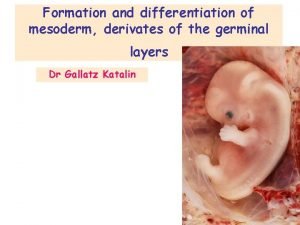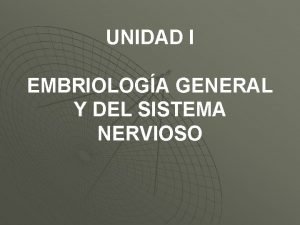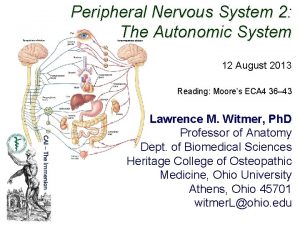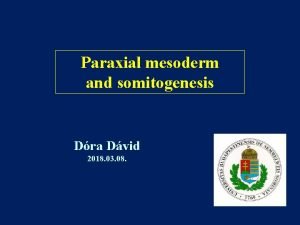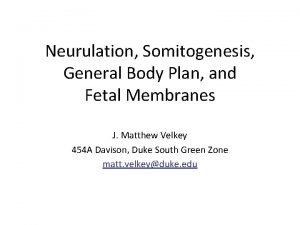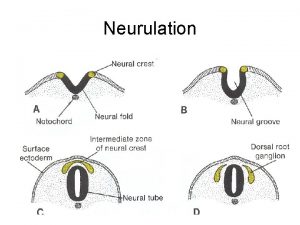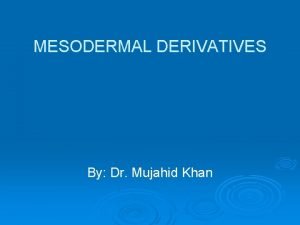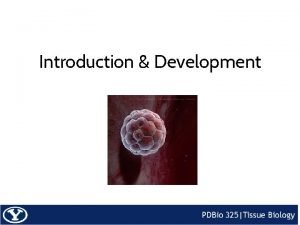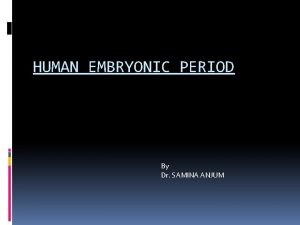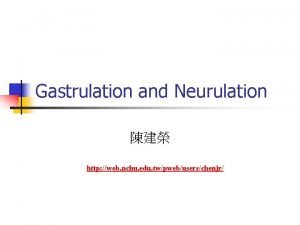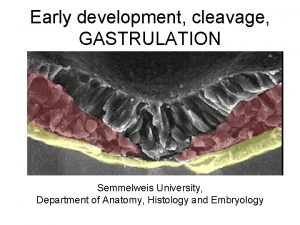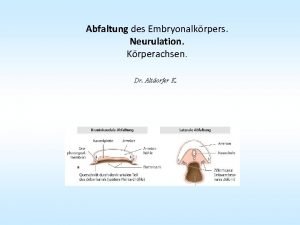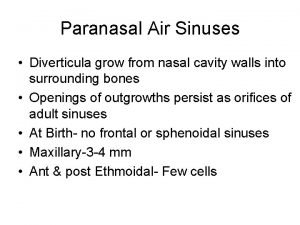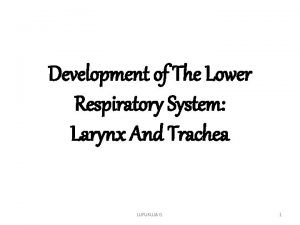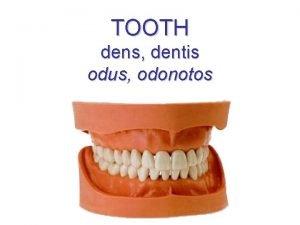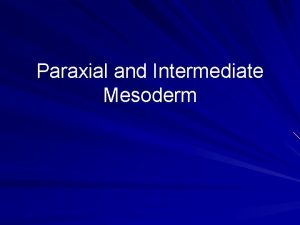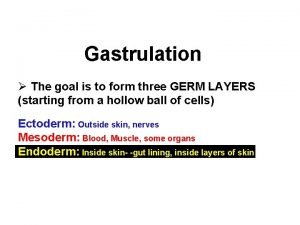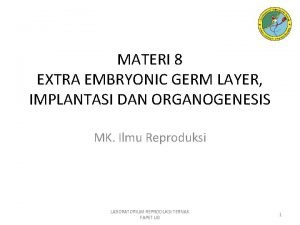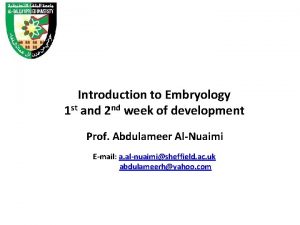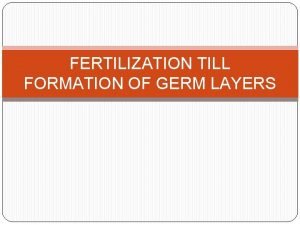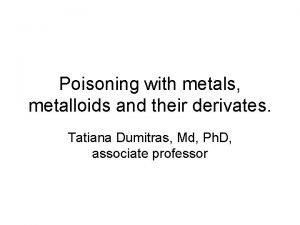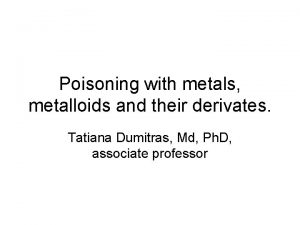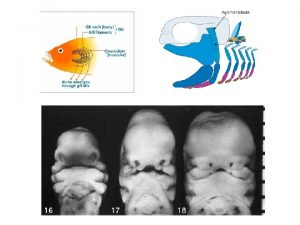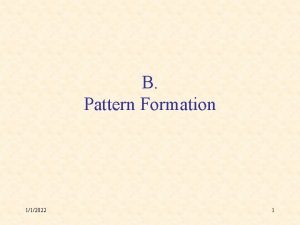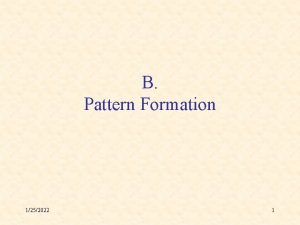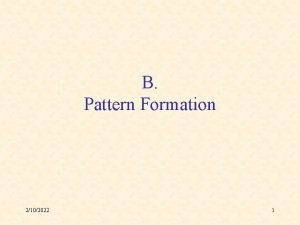Formation and differentiation of mesoderm derivates of the




































- Slides: 36

Formation and differentiation of mesoderm, derivates of the germinal layers Dr Gallatz Katalin

What happened during the 1 st and 2 nd week? Gametogenesis, fertilization, cleavage. Blastulation, implantation. The embryonic disc. Formation of ectoderm and endoderm. Formation and differentiation of mesoderm. Derivatives of the germinal layers. Neurulation. Folding of the embryo FROM DR. MARK KOZSUREK

Cleavage of the zygote Consist of repeating mitotic divisions of the zygote, Resulting in a rapid incease of number of cells In this stage the dividing cells are called Blastomeres become smaller with each division. After 8 -cell-stage: compaction mediated by adhesion glycoproteins. Morula from 12 -16 cell stage inner and embryoblasts outer cell mass trophoblasts

3. Formation of the blastocyst Zona pellucida degenerates, fluid flows in, cavity appears between the cells blastocystic cavity

EPIBLAST/HYPOBLAST SEGREGATION

Summary of first week of the human development Stage 1. fertilization formation of the zygote Stage 2. 2 -3. days early stage of cleavage morula Stage 3. 4 -5. days free (unattached ) blastocyst Stage 4. 5 -6. days attachment of the blastocyst IMPLANTATION

9 -10 day – BILAMINAR STAGE

2. week (end)

A TRILAMINARIS Stage – 3. week 1. The hypoblasts induce the epiblasts, 2. The epiblasts proliferate, 3. From the caudal side of the embrionic disc develops the primitive streak, at the end of it appears the primitive node and pit 4. Dividing cells migrate under the epiblast layer along the primitive streak , 5. Mesoderm is formed TRILAMINAR EMBRIO: Ectoderm , mesoderm , endoderm

16 th day

Gastrulation – formation of the germ layers

Formation of mesoderm ( 3 -8. week)

Formation of the notochord 1. Prenotochordal cells invaginating in the primitive pit move forward to the prechordal plate 2. Notochord fuses with the underlying visceral hypoblasts, and its inferior wall degenerates and disappear. 3. Neuroenteric canal is formed between the amnion and yolk sac for a short time. 4. Definitív notochord develops from the cells of notochordal process between the prechordal plate and cloacal membrane Neuroenteric canal

DEVELOPMENT OF THE DEFINITIVE NOTOCHORD

- Induces the development of neural tube

Differentiation of the intraembryonic mesoderm

MESODERM Paraxial mesoderma - somite Intermediate mesoderma gononephrotom Parietal mesoderm somatopleura splanchnopleura

DIFFERENTIATION OF THE MESODERM 17 th day paraxial mesoderm lateral mesoderm. intermediate mesoderm (gononephrotom). Lateral mesoderm divides into 2 layers somatopleura and splanchnopleura. The cavity between them: intraembryonal coeloma. It is continouos with extraembryonal coeloma.

FROM DR. MARK KOZSUREK

FORMATION OF THE SOMITES - At the beginning of the 3 rd week somites (or somitomeres) appear both side of the notochord and developing neural tube - Somites appear first cranially (around the 20 th day), than develop caudally (3 pair/day). - 4 OCC, 7 CERV, 12 THOR, 5 LUMB, 5 SACR, 8 -10 COCC - In the head region neuromers (mesenchyma of the head) develop.

SOMITOGENESIS AND DIFFERENTIATION dermatomyotom 4 th week SCLEROTOM Ventromedial cells of the somites migrate and surround the neural tube and notochord sclerotom vertebra The remaining part is called dermatomyotom (muscles develop from it) dermatom, the dermis and subcutis develops from it


Somites are segmented in the whole length of the embryo, intermediate mesoderm is segmented rostrally only, while the lateral plate mesoderm is not segmented at all.

DERIVATES OF THE INTERMEDIATE MESODERM - The intermediate mesoderma or gononephrotom gives the kidneys and gonads - In the cervical and upper thoracic region it is segmentated , lower it forms a continuos nephrogen cord

Derivates of the lateral mesoderm From the somatopleura develops the body wall (PARIETAL LAYER OF THE SEROUS MEMBRANES). From the splanchnopleura mesothelial cells, visceral layer of the serous membranes develop. (pleura, pericardium, peritoneum).

neural tube somite notochord intraembryonic coelom → body cavities (pericardium, pleura, peritoneum) splanchnic mesoderm visceral layer of serous membranes somatic mesoderm parietal layer of serous membranes FROM DR. MARK KOZSUREK lateral plate mesoderm gut intermediate mesoderm kidney, ureter, male genital tract

ectoderm epiblasts primitive streak hypoblasts yolk sac endoderm All the tissues and cells of the human body are derived from the epiblasts! intraembryonic mesoderm ? endoderm extraaembryonic mesoderm FROM DR. MARK KOZSUREK

EMBRYOGENESIS 1. Separation of the embrional-extraembrional tissues 2. Gastrulation: formation of the germ layers – EKTO-, ENDO-, MESODERM 3. Neurulation: formation of the neural tube and crest (CNS AND PNS) 4. Differentiation of the mesoderm

Germ layer derivatives

ECTODERM 1. Neuroectoderm neural plate neural crest placodes 2. Surface ectoderm FROM DR. MARK KOZSUREK

NEURAL PLATE – NEURAL TUBE Neurons and glial cells of the central nervous system CNS (except the microglia) Retina, dilator and constrictor of pupil muscles of the eye NEURAL CREST Peripheral nervous system PNS medulla of the adrenal gland melanocytes (which contain melanin pigment) aorticopulmonary septum of the heart odontoblasts

PLACODS otic placode: epithelial and neural elements of the vestibulocochlear system (organs of hearing and equilibrium) olphactory (nasal) placode: primary neuroepithelial cells of the nasal cavity optic (lens) placode: lens of the eye adenohypophyseal placode: hormone secreting cells of the adenohypophysis trigeminal placode: gives rise to the cells of the trigeminal ganglion epibranchial placode: taste buds of the tongue, soft palate and laryngeal inlet, neurons and supporting cells of taste-sensing ganglia of the facial glossopharyngeal and vagus nerves. SURFACE ECTODERM Epidermis, hair, nails, sebaceous and sweat glands of the skin Epithelium of the corne and conjunctiva, epithelium of the lacrimal apparatus Epithelium and glands of the oral and nasal cavity, enamel of the teeth, salivary glands Mammary glands Epithelium and glands of the anus, epithelium of the spongy part of the male urethra

MESODERM EPITHELIAL TYPE (densly packed cells) Intermediate mesoderm → epithelium of the kidney, ureter and the male genital tract (epididymis, ductus deferens, seminal vesicle) Somato-splanchnopleural junction → cortical cells of the suprarenal gland, gonadal epithelia (not including the germ cells!), epithelium of the uterine tube, uterus and the upper vagina Somato- and splanchnopleura → mesothelium (simple squamous epithelium) MESENCHYMAL TYPE Circulatory system, including the endothelium of blood and lymph vessels, cardiac muscle, formed elements of blood and lymphatic cells Connective and supportive tissues – all of them!!! Smooth muscles (not including those in the eyeball!) Microglia

ENDODERM Epithelium and glands of the GI tract (including liver, gallbladder and pancreas) Epithelium of the urinary bladder, the prostate, the prostatic part of the male urethtra and the whole length of the female urethra Epithelium and glands of the airways (trachea, bronchi and alveoli of the lungs) Epithelium of the tympanic cavity and auditory tube Thyroid, parathyroid glands Thymus, tonsills

SUMMARY

Thank you for your attention!
 Differentiating inverse trigonometric functions
Differentiating inverse trigonometric functions Splanchnic mesoderm
Splanchnic mesoderm Mast cell progenitor
Mast cell progenitor Mesoderm ectoderm and endoderm
Mesoderm ectoderm and endoderm Formation initiale vs formation continue
Formation initiale vs formation continue Neurulacion semana
Neurulacion semana Sympathetic and parasympathetic nervous system difference
Sympathetic and parasympathetic nervous system difference Limbuds
Limbuds Mesoderm somites
Mesoderm somites Derivatives of paraxial mesoderm
Derivatives of paraxial mesoderm Mesoderm
Mesoderm Neural crest cells derivatives mnemonic
Neural crest cells derivatives mnemonic Parietal mesoderm
Parietal mesoderm Gastrulation
Gastrulation Cleavage
Cleavage Abfaltung
Abfaltung Splanchnic mesoderm
Splanchnic mesoderm Development of respiratory system
Development of respiratory system Lamina dentalis
Lamina dentalis Intermediate mesoderm
Intermediate mesoderm Gastrulation semaine
Gastrulation semaine Development of urinary bladder
Development of urinary bladder Germ layer
Germ layer Heuser's membrane
Heuser's membrane Gastrulation
Gastrulation Hát kết hợp bộ gõ cơ thể
Hát kết hợp bộ gõ cơ thể Frameset trong html5
Frameset trong html5 Bổ thể
Bổ thể Tỉ lệ cơ thể trẻ em
Tỉ lệ cơ thể trẻ em Gấu đi như thế nào
Gấu đi như thế nào Chụp phim tư thế worms-breton
Chụp phim tư thế worms-breton Hát lên người ơi alleluia
Hát lên người ơi alleluia Các môn thể thao bắt đầu bằng tiếng nhảy
Các môn thể thao bắt đầu bằng tiếng nhảy Thế nào là hệ số cao nhất
Thế nào là hệ số cao nhất Các châu lục và đại dương trên thế giới
Các châu lục và đại dương trên thế giới Công của trọng lực
Công của trọng lực Trời xanh đây là của chúng ta thể thơ
Trời xanh đây là của chúng ta thể thơ

